High-Performance CsPbBr3 Quantum Dot/ZTO Heterojunction Phototransistor with Enhanced Stability and Responsivity
IF 4.8
2区 化学
Q2 CHEMISTRY, PHYSICAL
引用次数: 0
Abstract
Although all inorganic metal halide perovskite quantum dots (QDs) have shown great potential in photodetectors, many reported devices still suffer from low responsivity due to poor mobility and high defect densities. To overcome these challenges, heterojunction structures that separate electron and hole pathways have emerged as a promising approach to improve the responsivity by reducing radiative recombination. Two-dimensional materials such as graphene and MoS2 have been integrated with perovskites to enhance performance; however, these materials often lead to high dark-state currents, which hinder the on/off ratios in photodetectors. Hence, identifying alternative functional materials that can complement perovskite QDs while minimizing these drawbacks is critical. Amorphous metal oxide semiconductors, such as zinc tin oxide (ZTO), have attracted attention as high-performance channel materials in thin-film transistors (TFTs) due to their high field-effect mobility, thermal stability, and ability to be processed at low temperatures over large areas. However, ZTO suffers from persistent photoconductivity (PPC) caused by oxygen vacancies, which leads to slow response times and prolonged conductivity after light exposure, thereby limiting its effectiveness in optoelectronic devices. In this work, we demonstrate a high-performance phototransistor using a planar heterojunction structure composed of CsPbBr3 quantum dots and ZTO via a simple solution-processing method. This device exhibits a responsivity of over 103 A/W, a specific detectivity of 7.0 × 1014 Jones, and an on/off ratio of 5 × 104 under 390 nm light illumination with an intensity of 0.03 mW/cm2. The combination of ZTO and CsPbBr3 QDs offers significant improvements over devices that lack either layer, showcasing superior performance compared to that of most perovskite photodetectors.

求助全文
约1分钟内获得全文
求助全文
来源期刊

The Journal of Physical Chemistry Letters
CHEMISTRY, PHYSICAL-NANOSCIENCE & NANOTECHNOLOGY
CiteScore
9.60
自引率
7.00%
发文量
1519
审稿时长
1.6 months
期刊介绍:
The Journal of Physical Chemistry (JPC) Letters is devoted to reporting new and original experimental and theoretical basic research of interest to physical chemists, biophysical chemists, chemical physicists, physicists, material scientists, and engineers. An important criterion for acceptance is that the paper reports a significant scientific advance and/or physical insight such that rapid publication is essential. Two issues of JPC Letters are published each month.
 求助内容:
求助内容: 应助结果提醒方式:
应助结果提醒方式:


